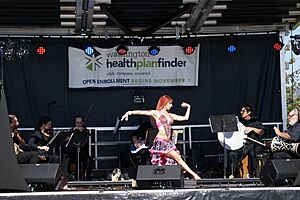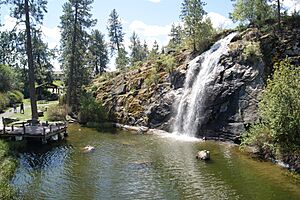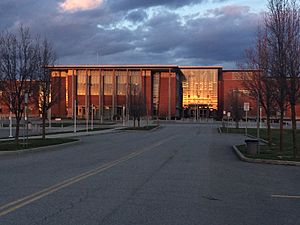Spokane Valley, Washington facts for kids
Quick facts for kids
Spokane Valley, Washington
|
||
|---|---|---|
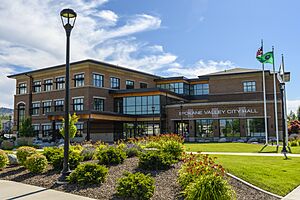
Spokane Valley City Hall
|
||
|
||
| Nickname(s):
The Valley
|
||
| Motto(s):
"A community of opportunity where individuals and families can grow and play, and businesses will flourish and prosper."
|
||
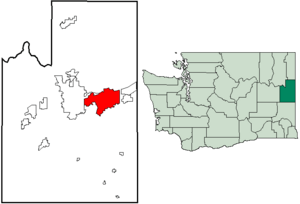 |
||
| Country | United States | |
| State | Washington | |
| County | Spokane | |
| Settled | 1849 | |
| Incorporated | March 31, 2003 | |
| Named for | Spokane Valley | |
| Government | ||
| • Type | Council–manager | |
| • Body | Spokane Valley City Council | |
| Area | ||
| • City | 38.01 sq mi (98.44 km2) | |
| • Land | 37.72 sq mi (97.69 km2) | |
| • Water | 0.29 sq mi (0.75 km2) | |
| Elevation | 2,002 ft (610 m) | |
| Population
(2020)
|
||
| • City | 102,976 | |
| • Estimate
(2023)
|
108,235 | |
| • Rank | US: 295th WA: 8th |
|
| • Density | 2,679.22/sq mi (1,034.46/km2) | |
| • Urban | 447,279 (US: 90th) | |
| • Metro | 597,919 (US: 97th) | |
| • CSA | 781,497 (US: 70th) | |
| Time zone | UTC-8 (Pacific (PST)) | |
| • Summer (DST) | UTC-7 (PDT) | |
| ZIP Code |
99206, 99216, 99212, 99016, 99027, 99037
|
|
| Area code(s) | 509 | |
| FIPS code | 53-67167 | |
| GNIS feature ID | 1967430 | |
Spokane Valley is a city in Spokane County, Washington, United States. It is the biggest suburb of Spokane. The city is located east of Spokane and west of Coeur d'Alene, Idaho. It also surrounds the city of Millwood on three sides.
Spokane Valley officially became a city on March 31, 2003. In 2020, about 102,976 people lived there, making it the ninth-largest city in Washington state. The city gets its name from the valley of the Spokane River where it is located. People in the area often call it "The Valley." Spokane Valley is a fun place with many community events. These include the Spokane County Interstate Fair and Valleyfest. It is also home to the Spokane Valley Heritage Museum. The Spokane Indians minor league baseball team plays here too.
Contents
History of Spokane Valley

The City of Spokane Valley was officially formed on March 31, 2003. When it became a city, it was the third-largest new city in U.S. history. Before this, it was made up of several smaller communities. These included Dishman, Opportunity, Trentwood, Veradale, and parts of Greenacres and East Spokane.
People wanted Spokane Valley to become a city for a few reasons. They wanted more say in how their local area was run. They also wanted to avoid being taken over by the larger City of Spokane. There had been four tries to make it a city before it finally happened in 2002. Some people worried that becoming a city would mean higher taxes. Others thought the services from Spokane County were good enough.
Geography and Landscape
Spokane Valley covers about 38 square miles (98 square kilometers). Most of this area is land, with a small part being water. One small lake in the city is Shelley Lake. The Saltese Creek feeds into this lake.
The city sits along the Spokane River. This river flows from Lake Coeur d'Alene and eventually reaches the Columbia River. Most of Spokane Valley is south of the river. To the south of the valley are parts of the Selkirk Mountains. The valley itself was shaped by huge floods long ago. These were called the Missoula Floods, which happened about 12,000 to 15,000 years ago. These floods carved out the valley.
The city's edges are marked by Havana Street and the Dishman Hills Conservation Area to the west. To the north are Felts Field, the city of Millwood, and the Spokane River. Barker Road is to the east, and small hills divide the city from the Palouse region to the south. Spokane Valley is part of a larger area called the Spokane–Coeur d'Alene Combined Statistical Area. It is located right between the cities of Spokane and Coeur d'Alene.
Neighborhoods and Communities in Spokane Valley
Before World War II, Spokane Valley was mostly a rural area with many farms and orchards. In 1940, about 10,000 people lived here. After the war, more people moved to the Spokane area. They started settling in quieter, less crowded places like the valley. By 1970, it had grown into a suburb with 60,000 residents.
When Spokane Valley became a city in 2003, it brought together several historic communities. These included Opportunity, Dishman, Veradale, Greenacres, Trentwood, Yardley, and Chester. Because the city shares its name with the larger area, "Spokane Valley" often refers to a bigger region than just the city limits.
Spokane Valley Climate
Spokane Valley has a mild climate with warm summers and rainy winters. On average, it gets a little over 16 inches (406 mm) of rain each year. December usually has the most rain, and July has the least. July is the warmest month, with an average temperature of 73°F (23°C). January is the coldest, with an average of 28.3°F (-2°C).
| Climate data for Spokane (Felts Field) 1998-present normals and extremes | |||||||||||||
|---|---|---|---|---|---|---|---|---|---|---|---|---|---|
| Month | Jan | Feb | Mar | Apr | May | Jun | Jul | Aug | Sep | Oct | Nov | Dec | Year |
| Record high °F (°C) | 59 (15) |
60 (16) |
74 (23) |
87 (31) |
95 (35) |
113 (45) |
112 (44) |
112 (44) |
102 (39) |
86 (30) |
69 (21) |
63 (17) |
113 (45) |
| Mean maximum °F (°C) | 51.5 (10.8) |
53.4 (11.9) |
64.9 (18.3) |
76.2 (24.6) |
86.6 (30.3) |
93.5 (34.2) |
100.3 (37.9) |
99.2 (37.3) |
90.6 (32.6) |
75.3 (24.1) |
59.6 (15.3) |
51.6 (10.9) |
101.9 (38.8) |
| Mean daily maximum °F (°C) | 37.1 (2.8) |
42.5 (5.8) |
51.0 (10.6) |
59.0 (15.0) |
68.6 (20.3) |
75.2 (24.0) |
87.0 (30.6) |
85.6 (29.8) |
75.6 (24.2) |
60.2 (15.7) |
44.8 (7.1) |
36.6 (2.6) |
60.3 (15.7) |
| Mean daily minimum °F (°C) | 26.2 (−3.2) |
27.2 (−2.7) |
31.7 (−0.2) |
36.2 (2.3) |
43.3 (6.3) |
50.3 (10.2) |
56.2 (13.4) |
54.8 (12.7) |
46.6 (8.1) |
37.9 (3.3) |
30.6 (−0.8) |
25.6 (−3.6) |
38.9 (3.8) |
| Mean minimum °F (°C) | 9.3 (−12.6) |
13.8 (−10.1) |
20.4 (−6.4) |
26.8 (−2.9) |
32.0 (0.0) |
41.3 (5.2) |
46.4 (8.0) |
45.5 (7.5) |
36.0 (2.2) |
25.6 (−3.6) |
17.1 (−8.3) |
9.4 (−12.6) |
2.5 (−16.4) |
| Record low °F (°C) | −10 (−23) |
−3 (−19) |
2 (−17) |
24 (−4) |
28 (−2) |
37 (3) |
39 (4) |
40 (4) |
26 (−3) |
12 (−11) |
−2 (−19) |
−10 (−23) |
−10 (−23) |
| Average precipitation inches (mm) | 1.92 (49) |
1.14 (29) |
1.91 (49) |
1.23 (31) |
1.51 (38) |
1.66 (42) |
0.40 (10) |
0.51 (13) |
0.61 (15) |
1.10 (28) |
1.94 (49) |
2.31 (59) |
16.25 (413) |
Who Lives in Spokane Valley?
| Historical population | |||
|---|---|---|---|
| Census | Pop. | %± | |
| 2000 | 80,927 | — | |
| 2010 | 89,755 | 10.9% | |
| 2020 | 102,976 | 14.7% | |
| 2023 (est.) | 108,235 | 20.6% | |
| U.S. Decennial Census 2000 2010 2020 |
|||
Spokane Valley first appeared as a city in the 2010 U.S. Census. It was formed in 2003 from several smaller areas. In 2020, there were 102,976 people living in Spokane Valley. There were also 45,163 households.
Most people living in Spokane Valley are White. Other groups include Black or African American, Native American, Asian, and Pacific Islander people. About 7% of the population is Hispanic or Latino. In 2010, the average age in the city was 37.3 years. About 24% of residents were under 18 years old.
Arts and Culture in Spokane Valley
Places of Worship
Spokane Valley has different places of worship. The Spokane Islamic Center opened in 2009. It was the first mosque in the Spokane area. There are also a Jewish synagogue and two Sikh temples in the city. The larger valley area is also home to a temple for The Church of Jesus Christ of Latter-day Saints. This temple was built in 1999.
Arts and Theater
The Spokane Valley Arts Council helps support the arts in the city. This group started in 2004. They show art from local artists at the CenterPlace Regional Event Center. They also help create sculptures for parks and buildings. Each October, they have an event to show and sell art.
For live shows, the Spokane Valley Summer Theatre puts on plays. They perform at the Central Valley Performing Arts Center. This center is located at Central Valley High School.
Spokane Valley Museums
Spokane Valley Heritage Museum
The Spokane Valley Heritage Museum opened in 2005. It is in the old Opportunity Township Hall, which has a Spanish mission-style design. The museum collects and shows the history of Spokane Valley. It has old newspapers, photos, and exhibits. These exhibits tell stories about the Native Americans who lived in the valley. They also show the history of apple orchards and early aircraft in the area.
Community Events in Spokane Valley
Spokane County Interstate Fair
Every year, after Labor Day, the Spokane County Fair and Expo Center hosts the Spokane County Interstate Fair. This fair lasts for ten days. It has many fun activities like carnival games, rides, and food. There is also a rodeo and a livestock show. Live music is often part of the fair too.
The Fair and Expo Center is a large place. It has over 140,000 square feet (13,000 square meters) of space for shows. Many different events happen there all year long.
Valleyfest
Valleyfest is a yearly festival held in September. It takes place at Mirabeau Point Park and the CenterPlace Regional Event Center. The festival includes a parade called "Hearts of Gold" on Sprague Avenue. There is also "Fishing at the Falls" and a classic car show. You can join a 5K or 10K run, or a duathlon. The event also has live music and other activities.
Inland NW Craft Beer Festival
The Inland Northwest Craft Beer Festival is a two-day event in September. It happens at Avista Stadium. This festival shows off beers from local and Washington state breweries. Sometimes, breweries from other western states also join. The festival has live music and food trucks. One day of the festival is family-friendly, with fun activities like a bouncy house.
Sports in Spokane Valley
The Spokane Indians are a baseball team that plays in Spokane Valley. They are a High Single-A team in the Northwest League. They are also a farm team for the Colorado Rockies. The Indians play their home games at Avista Stadium, which can hold 6,803 fans. They have won seven Northwest League titles since 1982.
Spokane Valley also hosts the annual Cycle Celebration. This is a bike riding event for all skill levels. There are routes of 10, 25, and 50 miles. All routes start at Mirabeau Point Park. The longer routes go through hills and prairies, offering great views of Mica Peak and Mount Spokane.
Parks and Recreation
Spokane Valley has about 254 acres (1 square kilometer) of parks and open spaces. One of the most famous parks is Mirabeau Point Park. It has the CenterPlace Regional Event Center and the Discovery Playground. The park also has walking trails and a beautiful artificial waterfall called Mirabeau Springs. This area is popular for rock climbing. The park also connects to the Centennial Trail. Spokane Valley also has three outdoor swimming pools that are open in the summer.
Education in Spokane Valley
Spokane Valley has one public library. It is part of the Spokane County Library District. This library has a studio where people can record and produce things. Most adults in the city have a high school diploma. About 23% have a college degree or higher.
Public schools in Spokane Valley are run by several different school districts. These include the Central Valley School District (CVSD), West Valley School District (WVSD), and East Valley School District (EVSD). Some parts of western Spokane Valley are served by Spokane Public Schools (SPS). CVSD is the largest district in the valley.
There are also several private schools in the city. Many of these are religious schools. Examples include Valley Christian School and The Oaks Academy. High school students can also go to Spokane Valley Tech. This school offers free technical training. It helps students get skills for future jobs and prepare for college.
Long ago, Spokane Valley had a college called Spokane University. It was founded in 1913 and closed in 1933. Today, University High School and Valley Christian School are on the old college campus. For higher education now, Carrington College has a campus in Spokane Valley. It offers programs in healthcare fields.
Media
Spokane Valley is part of Spokane's television and radio markets. The city has a weekly newspaper called the Valley News Herald. It is published every Friday. This newspaper was formed in 1996 when two older papers merged.
Infrastructure and Services
Transportation in Spokane Valley

Spokane Valley has many curvy streets and dead-end roads. This is common in suburbs. Sprague Avenue is a main road for shopping and travel. It goes east-west from downtown Spokane to Liberty Lake. Other important east-west roads include Trent Avenue and Mission Avenue. For north-south travel, major roads are Argonne/Mullan roads, Pines Road, Evergreen Road, and Sullivan Road.
Interstate 90 runs through Spokane Valley. It connects the city to Seattle, Washington in the west and Boston, Massachusetts in the east. You can get on or off I-90 at exits 285 to 293. The average time people spend commuting to work is about 21 minutes. Traffic on the interstate can get busy. The Washington State Department of Transportation is adding ramp meters to help with traffic flow.
Public Transportation
The Spokane Transit Authority (STA) provides public transportation for Spokane Valley. They have the Pence-Cole Valley Transit Center (VTC). There are also places to park and ride throughout the city. Spokane Valley has some public transit options, but most people rely on cars.
Airports
The main airport for Spokane Valley is Spokane International Airport. It is about 16 miles (26 km) west in Spokane. Six airlines use this airport. Felts Field is another airport near Spokane Valley. It is for smaller planes and is located along the Spokane River.
Healthcare in Spokane Valley
Spokane Valley has one main hospital, MultiCare Valley Hospital. There are also special clinics and urgent care centers. These are run by MultiCare Health System, Providence Health & Services, and CHAS Health. CHAS Health helps people who do not have health insurance. Ambulance services in Spokane County are provided by American Medical Response.
Utilities and Services
Different companies provide electricity in Spokane Valley. These include Avista Utilities, Inland Power & Light, and Modern Electric Water Company. Water service also comes from various providers. This is because the area used to be rural with many farms. The city gets its water from the Spokane Valley–Rathdrum Prairie Aquifer.
For sewer services, Spokane County Environmental Services is the only provider. Avista Utilities is the only provider for natural gas. For cable TV and internet, residents can use Xfinity Comcast, Centurylink, and other smaller companies.
See also
 In Spanish: Spokane Valley (Washington) para niños
In Spanish: Spokane Valley (Washington) para niños







